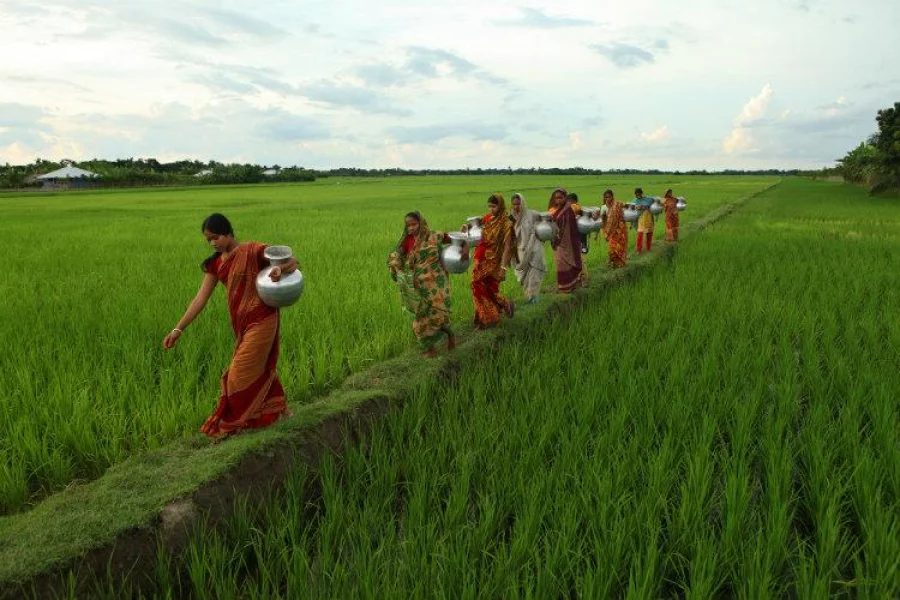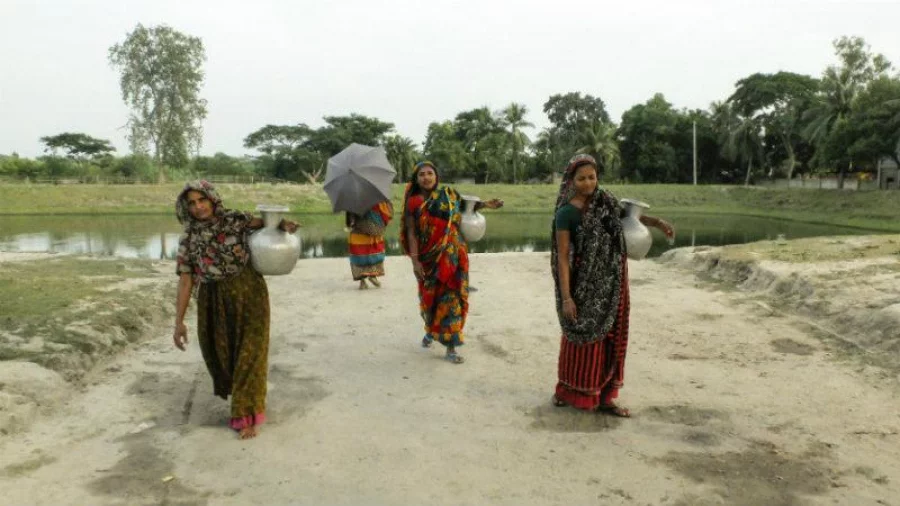The effects of climate change are devastating for all. The uneven distribution of suffering, however, raises further worries.
A variety of factors result in differentiated impacts across the globe. The geographic and socio-economic conditions of a place will undoubtedly play a role in shaping the type and extent of climate change impacts faced by its people.
However, there are additional components to be taken into account when addressing climate vulnerability, and the critical issue of gender is one such element that seeps through all the layers of this already complex issue.
Dr Farhana Sultana, who has carried out research work for many years in Bangladesh, offers additional insights to the gendered implications of climate change in one of her latest book chapters ‘Gender and Water in a Changing Climate: Challenges and Opportunities.’ This article is a summary of the main points of that chapter, which appear in the book Water Security Across the Gender Divide (C Fröhlich, G Gioli, R Cremades and H Myrttinen (Eds), Springer: The Netherlands).
Dr Sultana starts by alerting readers that climate change alters environmental and water resources in dramatic ways, and since access, control, use, and knowledge of resources are gendered, any climate-induced changes to natural resources will create different vulnerabilities for different genders.
She states that it is “imperative to undertake multi-scalar, critical, and intersectional analyses to better inform both academic debates and policymaking. Heeding gendered implications of climate change is particularly important as patriarchal norms, inequities, and inequalities often place women and men in differentiated positions in their abilities to respond to and cope with dramatic changes.”
As we go into the depths of the issue, it can be understood that even within gender groups there are many intersecting factors such as class, age, and ability, and this creates a constellation that does not allow for simplified category-based decision making when planning for climate change. This is because gender is always intersected by other social axes.
As such, it is essential that the growing base of climate change work is developed from a gendered perspective and takes into account the associated power dynamics when devising research and action plans aimed to tackle climate change ’s inevitable impacts.
A gendered view of the burden of climate change
Many scholars have confirmed that natural resource-dependent communities are highly at risk from climate change-driven stressors and events, especially regarding water issues.
A changing climate will lead to uncertainties and irregularities in rainfall and beneficial flood, while also provoking more frequent and intensified storms, cyclones, riverbank erosions, and catastrophic flooding. This will create a range of sufferings in societies. Many will be vulnerable.
When studying the variables affecting social vulnerabilities, the hydrological, geo-morphological and biophysical changes affecting regions and localities are all taken into consideration, and only then can adaptation options be assessed.
However, is that all that matters? Does it mean it is safe to say that considering the above factors everyone in this particular community will be affected in the very same way when a major climatic event strikes?
Perhaps not, as climate change and its impacts are definitely uneven. Within communities, the vulnerabilities of men and women will vary significantly, as will their ability to cope with these events and changes.
Their ability to cope is not due to any inherent differences between men and women, but more because of the societal and cultural norms that limit differently positioned women and girls in very different ways, and as a result, can often render them less capable and more vulnerable to any ecological changes brought on by a changing climate.
Dr Sultana explains in the following passage:
“Men and women experience, understand, and adapt to climate change in different ways, and it is important to understand changes currently taking place, and likely to happen in the near future, from a gendered perspective. Climate change is likely to exacerbate gendered vulnerabilities and differential abilities to cope with changes on multiple fronts. Although climate change is often framed as a global problem for all of humanity, the heterogeneity of its manifestations, impacts, and responses has to be carefully considered. Even though climate change is often portrayed as affecting the poor uniformly in the Global South, this is further complicated by gendered power relations that are intersected with other social differentiations (e.g., class, race, ethnicity, etc.)”
 Gendered implications can't be ignored. Photo: Syed Zakir Hosain
Gendered implications can't be ignored. Photo: Syed Zakir Hosain
Societal challenges that increase gendered vulnerabilities
Scholars, with data and evidence, have shared that in many cases it is true that more women compared to men are killed and injured during disasters such as cyclones, floods, and storms.
Additionally, there are studies in Bangladesh that state that during floods and salinity intrusion, women have it much worse than men living in the same community as they are generally tasked with procuring drinking water for the household.
Considering that this aligns with findings from other parts of the developing world as well, we should be looking at asking the persistent deleterious gendered impacts of climate change and the resultant environmental change.
In many cultures, especially in rural societies across South Asia, the role of women in the community and household is largely socially and culturally determined. Women are responsible for domestic duties and care for the household, tending to the elderly, raising the children, looking over the livestock and so on.
Women are also often the primary caregivers. Such responsibilities constrain women’s and girls’ abilities as well as the vulnerabilities they bear. “Cultural constraints on what they can or should do to protect themselves often result in greater mortality rates among women and girls compared to men and boys,” Dr Farhana Sultana writes.
The chapter also discusses how women often die during floods due to lack of swimming skills or by trying to stay behind to save their children and belongings. Women’s access to information is also limited, as many women in rural societies are deprived of participating in community meetings or cyclone preparedness training that are meant to capacitate them against risks.
For conservative communities throughout Bangladesh, an additional concern lies in existing sociocultural norms that can prevent women from accessing shelter and medical assistance in times of disaster: “Notions of shame, honour, and dignity are strongly enforced by both men and women in maintaining social practices even during disasters.”
Dr Sultana states how these patriarchal insecurities are internalised by women themselves, who then feel uncomfortable in moving to shelter spaces even during catastrophic disaster events despite awareness-building in the country.
Furthermore, distress selling of women’s assets (such as jewellery or livestock) as a coping strategy of households in times of disasters further impoverish women over time. Understanding these related vulnerabilities that will worsen with climate change is thus important.
 Photo: Abu SiddiqueClimate change adaptation: Is it really for all?
Photo: Abu SiddiqueClimate change adaptation: Is it really for all?
While adaptation attempts are made to assist in dealing with the effects of climate change, studies show that in many cases their gender insensitive approach can reinforce marginalities and inequalities within the community.
Considering that the primary goal of adaptation is to ensure reduction of vulnerability, and vulnerability itself is entirely context driven and influenced by many interlinking forces, it is a complex task to ensure that adaptation sets a level playground for all within a community.
Although men and women are differently vulnerable, it certainly does not mean that all women are vulnerable to the same degree. The variety of social differences such as class, education, religion, age, etc all intersect with gender and create differential experiences. However, it is possible to recognize patterns.
Poorer and more marginalized women and girls may have different needs than what adaptation projects focus on, so identifying ways to be more equitable in outcomes becomes imperative.
Dr Sultana writes: “In enabling women to take part in decision-making processes and having their concerns and voices heard, there are opportunities to reduce women's heightened vulnerabilities, thereby allowing them to better resist, cope with, and adapt to changes.”
These are important things to think about when designing climate change adaptation strategies. Without a proper assessment of the differentiated vulnerabilities within a society, there is always a risk that adaptation actions will only target specific groups, which in most cases tend to be those who already have secured superior positions in society.
Dr Sultana concludes that climate change research and adaptation planning needs to undertake a more critical analysis of vulnerabilities, social structures, differentiated access to knowledge and resources, and the overall power relations that are at play both within households and in communities at large.
Climate change needs to be viewed through lenses of gender and intersectionality, and only then can we better understand the full impacts of climate change and accurately predict the aftermath of adaptation programs that are set to cope with such impacts.
Shababa Haque is trained as an environmentalist. She completed her Masters degree on Environmental Technology from Imperial College London. Since then she has worked in the field of climate change. She has also worked on building climate resilience for disabled persons in Bangladesh, and from there on developed her interest in strengthening adaptation for those who are disproportionately vulnerable to climate change.




